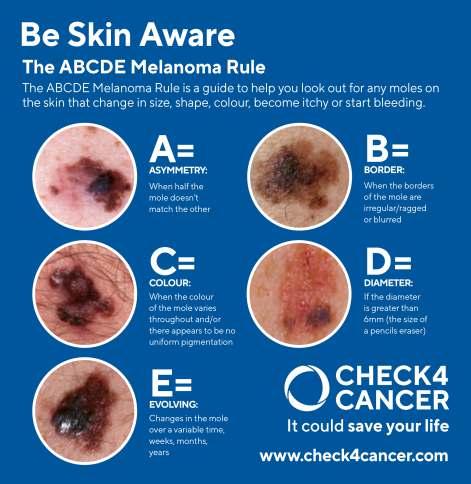
3 minute read
The Importance of Annual Skin Checks
May is Skin Cancer Awareness
Month, but according to a recent survey from the Prevent Cancer Foundation, 70% of Americans 21 years of age and older have not had a skin check in the past year
Advertisement
Survey participants’ most cited reasons for not being checked were not experiencing symptoms (29%), not knowing they need to be checked (26%), and inability to afford the cost (23%)
This news comes from a recent report from the Prevent Cancer Foundation that 65% of Americans 21 years of age and older say they are not up to date with one or more routine cancer screenings
This and other findings from the Foundation’s first annual Early Detection Survey emphasize the need for increased awareness and access to routine screenings for cancer prevention and early detection Early detection of cancer can mean less extensive treatment, more treatment options, and better chances of survival, leading to better outcomes
Skin cancer is the most common cancer diagnosis in the U S and is also one of the most preventable cancers Although a quarter of participants said they had a skin check for skin cancer between one and three years ago, nearly that same amount (24%) say they’ve never had a skin check for skin cancer

Advances in skin cancer screening and treatment have reduced the skin cancer mortality rate, but significant disparities in health outcomes persist Anyone, regardless of skin color, may develop skin cancer Skin cancers are less prevalent in non-white racialethnic groups, but when they occur, they tend to be diagnosed at a later stage and, as a result, have a worse prognosis
Skin cancer is less likely to be suspected in patients of color because it occurs less frequently, so these patients may be less likely to get regular full-body skin exams
According to survey results, Americans who said they were not up to date or did not know if they were up to date on their skin cancer check would be more likely to prioritize their screening if there was an at-home test
Online mental health screens reveal depression and suicidal thoughts still high
More than 6 3 million people worldwide in 2022 took a mental health screening using the Mental Health America (MHA) Online
Screening Program, a nearly 138% increase from 2020 and a 19% increase from 2021
Rates of depression, anxiety, and suicidal thoughts remain at the high 2021 levels, and more people screened at risk for mental health conditions are struggling the most with body image or self-image and relationship problems

MHA is releasing this data in conjunction with the start of May as Mental Health Month
This year’s theme, “Look Around, Look Within,” and accompanying resources focus on environmental impacts on mental health, including safe and stable housing, an individual’s neighborhood and town, and nature and the outdoors

Further analysis of domestic screeners reveals shifting concerns and disparities across multiple demographics Among individuals who screened positive or moderate to severe for a mental health condition in 2022, 60% reported body image or self-image as one of the top three contributors to their mental health concerns However, the differences in the highest contributors to mental health concerns among the individual races and ethnicities reveal inequities in the experience of 20212022
For example, American Indian or Alaska Native screeners were most likely to select abuse or violence (16%) and grief or loss (20%); Black or African American screeners were most likely to select relationship problems (54%), financial problems (26%) and basic needs (5%), Asian screeners were most likely to select school or work problems (56%); and 50% of screeners who identified as more than one race were most likely to select loneliness or isolation
Another significant finding came from the addition of our ADHD screening in June 2022 Within six months of its addition, the ADHD screen surged in popularity, eclipsing both bipolar and anxiety in screens per month Data suggests that people are having a hard time staying on task as the world continues to adjust in the aftermath of the pandemic, with 84% of continues on B1 – Depression rates option (28%)
Currently, there is no at-home test option for skin cancer, but you should examine your skin monthly to look for possible signs of melanoma in addition to getting your skin checked annually by a health care provider The Prevent Cancer Foundation recommends using the ABCDEs of skin cancer as a helpful tool when checking your skin for suspicious moles:
Asymmetry
Border irregularity
Color that is not uniform
Diameter greater than 6mm
Evolving size, shape or color
Any changes in size, shape or elevation of a mole, or any new symptoms such as bleeding, itching or crusting, should be reported to a health care provider
“When it comes to cancer, early detection equals better outcomes,” said Heather Mackey, DNP, ANP-BC, AOCN, Senior Director of Cancer Prevention and Early Detection at the Prevent Cancer Foundation “It’s important for everyone to check their health with the routine cancer screenings they need at every age Monthly self-exams and annual skin checks are quick and easy preventive measures we can all prioritize not just during the summer months but year-round ”
Information and resources on all cancer types studied in the 2023 Early Detection survey including information on r e l e v a n t s c r e e n i n g s c a n b e f o u n d a t www preventcancer org/betteroutcomes For more information about skin cancer and ways to reduce your risk, visit www preventcancer org/skin







